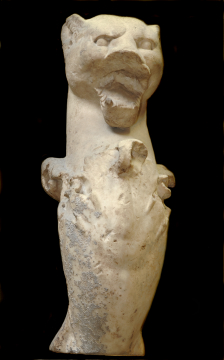Explore Collections


You are here:
CollectionsOnline
/
Fragmentary upper section of a Roman table leg
Browse
Fragmentary upper section of a Roman table leg
Pentelic marble
Height: 41cm
Museum number: M832
On display: Dome Area
All spaces are in No. 13 Lincoln's Inn Fields unless identified as in No. 12, Soane's first house.
For tours https://www.soane.org/your-visit
Curatorial note
This fragment is from the leg support of a low, heavy table and compises a panther head emerging from a rectangular joint-backing and rising from acanthus foliage about the outcurve of the body, which has been squared off slightly above the start of the paw.
A complete example from Smyrna in Berlin1 features the panther head and acanthus leaf/leaved body terminating in a massive lion's foot, such as Soane S56 (Vermeule 256); compare also the carved foot illustrated in the NY Carlsberg catalogue2. In describing a Trapezephoron (table leg) "formed of the head, breast, hind leg and pad of an Abyssinian lion", in the collection of Lord Leconfield3 the author notes that the arrangement of foliate (acanthus) leaves rolling over at the neck "lessens the incongruity of the sudden transition from the head to the leg" and creates a work that is carefully carried out with effective lines and balance of the figure.
The acanthus on the chest of this particular beast is a connection with the table-leg motive when used in carved relief as the base enframement in a pilaster scroll, such as in an example in the Vatican drawn by Robert Adam4. Here an elaborate central plant and double scroll rise from a calyx at the base, which is composed of scrolls starting from two copies of acanthus-lion trapezephoroi.
1 Königliche Museen zu Berlin, Beschreibung der antiken Skulpturen, Berlin, 1891, p. 426, no. 1078.
2 NY Carlsberg Glyptotek, Antik Kunst i Dansk Privateje, Copenhagen, 1974, pl. X, no. 134, also nos. 132 and 133.
3 Margaret Wyndham, Catalogue of the Collection of Greek and Roman Antiquities in the possession of Lord Leconfield, London-Medici Society 1916, no. 81 and plate. The Leconfield collection is at Petworth House, Sussex.
4 Soane Museum drawing Adam Vol. 26/40; compare P. Gusman, L'Art décoratif de Roma de la fin de la république au IV siecle, 2 vols, Paris, 1910, II, pl.120, no. 1
A complete example from Smyrna in Berlin1 features the panther head and acanthus leaf/leaved body terminating in a massive lion's foot, such as Soane S56 (Vermeule 256); compare also the carved foot illustrated in the NY Carlsberg catalogue2. In describing a Trapezephoron (table leg) "formed of the head, breast, hind leg and pad of an Abyssinian lion", in the collection of Lord Leconfield3 the author notes that the arrangement of foliate (acanthus) leaves rolling over at the neck "lessens the incongruity of the sudden transition from the head to the leg" and creates a work that is carefully carried out with effective lines and balance of the figure.
The acanthus on the chest of this particular beast is a connection with the table-leg motive when used in carved relief as the base enframement in a pilaster scroll, such as in an example in the Vatican drawn by Robert Adam4. Here an elaborate central plant and double scroll rise from a calyx at the base, which is composed of scrolls starting from two copies of acanthus-lion trapezephoroi.
1 Königliche Museen zu Berlin, Beschreibung der antiken Skulpturen, Berlin, 1891, p. 426, no. 1078.
2 NY Carlsberg Glyptotek, Antik Kunst i Dansk Privateje, Copenhagen, 1974, pl. X, no. 134, also nos. 132 and 133.
3 Margaret Wyndham, Catalogue of the Collection of Greek and Roman Antiquities in the possession of Lord Leconfield, London-Medici Society 1916, no. 81 and plate. The Leconfield collection is at Petworth House, Sussex.
4 Soane Museum drawing Adam Vol. 26/40; compare P. Gusman, L'Art décoratif de Roma de la fin de la république au IV siecle, 2 vols, Paris, 1910, II, pl.120, no. 1
Rome; collected in Rome by Charles Heathcote Tatham for the architect Henry Holland during the 1790s. See Cornelius Vermeule, unpublished catalogue of the Antiquities at Sir John Soane's Museum, Introduction, transcription of Tatham letters, List 3, no. 34. (Soane Archive).
Literature
Tatham: Etchings, 2; Drawings, 8.
Soane collections online is being continually updated. If you wish to find out more or if you have any further information about this object please contact us: worksofart@soane.org.uk


